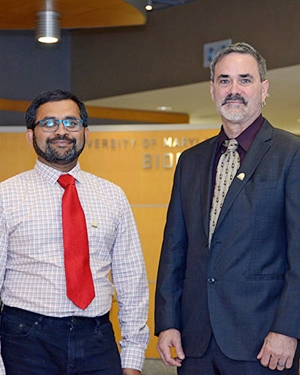Study Triples Human Microbiome Data
A new study of the human microbiome — the trillions of microbial organisms that live on and within our bodies — has uncovered millions of previously unknown genes from microbial communities in the human gut, skin, mouth, and vaginal microbiome, allowing for new insights into the role these microbes play in human health and disease.
The study, from researchers at the University of Maryland School of Medicine (UMSOM), Harvard T.H. Chan School of Public Health, the Broad Institute of the Massachusetts Institute of Technology and Harvard, and the University of California, San Diego, triples the amount of data previously analyzed in this project, and is the largest human microbiome study ever.
This work appears in the latest issue of the journal Nature.
The results are a significant jump in the amount of information available to scientists. This publication provides new insight into the changes in our microbiome over time and could lead to a greater understanding of the genetic differences that are unique to an individual’s microbes.

Anup Mahurkar, MIM and Owen White, PhD
“This new data really expands our appreciation for the fingerprint created by microorganisms that make up each human’s microbiome,” says Owen White, PhD, professor of epidemiology and public health and associate director at the Institute for Genome Sciences (IGS) at UMSOM. “These organisms play a crucial role in many key aspects of our health. The more we know about them and their role, the more likely it is that we will be able to manipulate them to improve our health.”
This study is part of the National Institutes of Health Human Microbiome Project, launched in 2008 to identify and characterize human microbes, explore microbes’ relationship to health and disease, and develop computational tools to analyze the microbes. The microbiome has been linked to various aspects of human health including the robustness of our immune system and our susceptibility to chronic illnesses such as Crohn’s disease and cancer.
This work is a continuation of work published in Nature in 2012. In the new study, the researchers analyzed an additional 1,635 new microbiome samples, for a total of 2,355 sampled from 265 people over time. The scientists used DNA sequence analysis tools to identify which organisms are present in various body sites, determine whether they change or stay relatively stable over time, and explore their function. This study also provides one of the largest profiles of non-bacterial members — viruses and fungi — of the microbiome. In addition, it unraveled some of the biochemical activity that allows microbes to play a role in human health.
Although the new study illuminates a great deal about the microbiome, an enormous amount remains unknown. Learning more about it will take time, said Anup Mahurkar, MIM, the executive director of software engineering and information technology at IGS. “These communities of organisms are tremendously complex. In one sense, this study is a great advancement for the research community,” he said. Mahurkar was responsible for the months of intensive computations required to process the data. However, he also was cautious, saying, “On the other hand, it still just moves the needle. There will always be more we can learn.” Mahurkar is confident that the work will provide a large data resource for other scientists to use in their future research.
Support for the study came from National Institutes of Health and the Crohn's & Colitis Foundation of America.
“The microbiome is one of the great undiscovered areas in medicine today, with links to many common and problematic chronic diseases,” said UMSOM Dean E. Albert Reece, MD, PhD, MBA, who also is the vice president for medical affairs, University of Maryland, and the John Z. and Akiko K. Bowers Distinguished Professor. “This pathbreaking research will open the door for a wide range of clinically relevant research in the years to come.”



